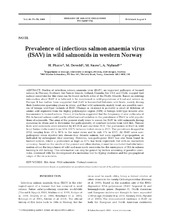| dc.contributor.author | Plarre, Heidrun | eng |
| dc.contributor.author | Devold, M. | eng |
| dc.contributor.author | Snow, M. | eng |
| dc.contributor.author | Nylund, Are | eng |
| dc.date.accessioned | 2012-08-20T09:15:13Z | |
| dc.date.available | 2012-08-20T09:15:13Z | |
| dc.date.issued | 2005-08-09 | eng |
| dc.identifier.issn | 0177-5103 | en_US |
| dc.identifier.uri | https://hdl.handle.net/1956/5957 | |
| dc.description.abstract | Studies of infectious salmon anaemia virus (ISAV), an important pathogen of farmed salmon in Norway, Scotland, the Faeroe Islands, Ireland, Canada, the USA and Chile, suggest that natural reservoirs for this virus can be found on both sides of the North Atlantic. Based on existing information about ISAV it is believed to be maintained in wild populations of trout and salmon in Europe. It has further been suggested that ISAV is transmitted between wild hosts, mainly during their freshwater spawning phase in rivers, and that wild salmonids, mainly trout, are possible carriers of benign wild-type variants of ISAV. Change in virulence is probably a result of deletions of amino acid segments from the highly polymorphic region (HPR) of benign wild-type isolates after transmission to farmed salmon. Hence, it has been suggested that the frequency of new outbreaks of ISA in farmed salmon could partly reflect natural variation in the prevalence of ISAV in wild populations of salmonids. The aims of the present study were to screen for ISAV in wild salmonids during spawning in rivers and to determine the pathogenicity of resultant isolates from wild fish. Tissues from wild salmonids were screened by RT-PCR and real-time PCR. The prevalence of ISAV in wild trout Salmo trutta varied from 62 to 100% between tested rivers in 2001. The prevalence dropped in 2002, ranging from 13 to 36% in the same rivers and to only 6% in 2003. All ISAV were nonpathogenic when injected into disease-free Atlantic salmon, but were capable of propagation, as indicated by subsequent viral recovery. However, non-pathogenic ISAV has also been found in farmed salmon, where a prevalence as high as 60% has been registered, but with no mortalities occurring. Based on the results of the present and other studies, it must be concluded that vital information about the importance of wild and man-made reservoirs for the emergence of ISA in salmon farming is still lacking. This information can only be gained by further screening of possible reservoirs, combined with the development of a molecular tool for typing virulence and the geographical origin of the virus isolates. | en_US |
| dc.language.iso | eng | eng |
| dc.publisher | Inter-Research | en_US |
| dc.relation.ispartof | <a href="http://hdl.handle.net/1956/5958" target="blank">Infectious salmon anaemia virus (ISAV): Evolution, genotyping, reservoirs and transmission</a> | en_US |
| dc.subject | ISA virus | eng |
| dc.subject | Wild salmonids | eng |
| dc.subject | Natural reservoir | eng |
| dc.title | Prevalence of infectious salmon anaemia virus (ISAV) in wild salmonids in western Norway | en_US |
| dc.type | Peer reviewed | |
| dc.type | Journal article | |
| dc.description.version | publishedVersion | en_US |
| dc.rights.holder | Copyright 2005 Inter-Research | en_US |
| dc.identifier.doi | https://doi.org/10.3354/dao066071 | |
| dc.identifier.cristin | 406894 | |
| dc.source.journal | Diseases of Aquatic Organisms | |
| dc.source.pagenumber | 71-79 | |
| dc.subject.nsi | VDP::Agriculture and fishery disciplines: 900::Fisheries science: 920 | en_US |
| dc.subject.nsi | VDP::Mathematics and natural science: 400::Basic biosciences: 470 | en_US |
| dc.identifier.citation | Diseases of Aquatic Organisms 66(1):71-79 | |
| dc.source.volume | 66 | |
| dc.source.issue | 1 | |
